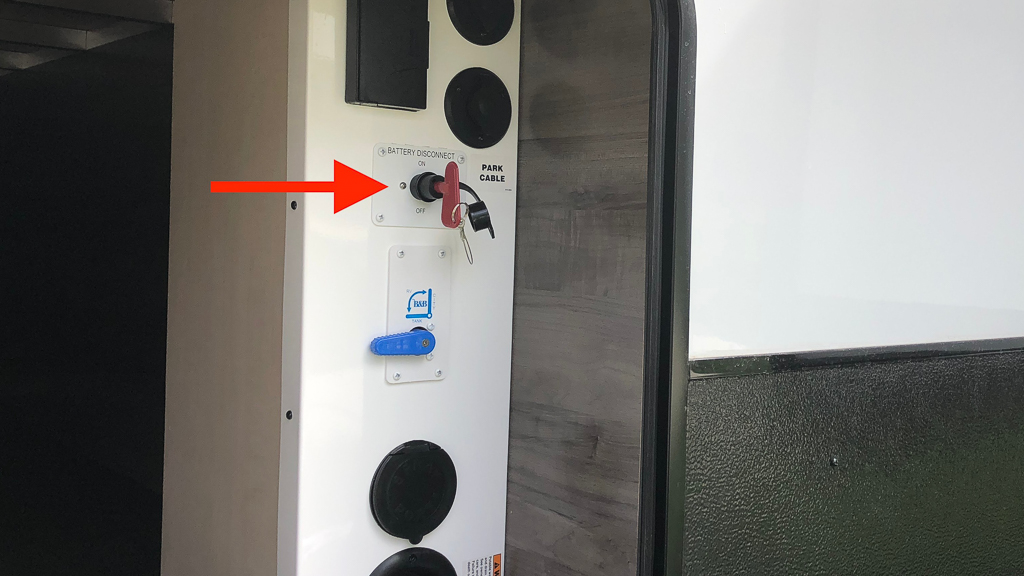
Killing the Phantom
When we put our trailer to bed for the winter we pull the batteries off the rig and put them on a float charger in the garage. During the season we leave the batteries installed and just make sure things are turned off. Imagin our surprise when we came to get the rig one day and the tongue jack wouldn’t move. In fact, nothing would work and after some quick troubleshooting, I found that we had a dead battery. I was able to get the tongue jack working up using my portable jump pack but this was a bit of a pain.
I have no doubt that this was caused by what is known as Phantom Power draw. This is the power that is used by devices when they are not truly in use. In a trailer, things like your CO detector and some indicator lights stay on full time and will ultimately drain your battery. So whats the solution to prevent this? Well, its to install a battery cutoff switch or breaker.
I was really excited to see that on my Winnebago Minnie Plus the docking station had a built-in cutoff switch. The issue I am finding in practice is that this does not actually cut off all access to the battery. The other day we went to where we store the trailer and found that the tongue-jack light was on. Left unattended that could have drained our battery and caused long-term damage to the cells. So to resolve this we need to install a positive cutoff switch that sits in-line right after the battery.
My choice for this project is a Blue Sea Systems Circuit Breaker. I have used this waterproof breaker for several different projects and have never had an issue. To connect it you simply insert it inline with the positive lead coming from the battery. You can do this by cutting the existing cable and then inserting the breaker where you made the cut. The other way and my preferred method is to disconnect the existing cable from the battery and connect it to one of the terminals on the breaker. Then attach one end of a new cable to the other terminal on the breaker and the other end of that cable to the battery. If you are using the second method, be sure to use the same gauge wire as your existing line. I chose to mount this on the backside of one of my battery boxes. Since the circuit breaker is waterproof, I have no issues with it being outside and exposed.
That’s all there is to it. Now when you are done and put your rig in storage, just press the red button and it will open the breaker and stop all connection to the battery. No more phantom draw on your battery. In addition. if the breaker is positioned a bit out of sight it has the added benefit of being a bit of extra security. With the battery fully disconnected, the tongue jack and electric stabilizers won’t work. This is easy enough to get around but it might just add enough additional delay that bad guys look elsewhere.




4 thoughts on “Killing the Phantom”
We too have a winnebago 2018 BHSS.
We are new to RV Life. Previously salt water sailors so we are able to get things done and learn the system but maybe our age late 60’s and early 70’s is causing this to be a challenge. Our lasted confusion is when we are off the grid, having run the generator until bedtime. we are finding in the morning the check lite on on the refrigerator and insufficient battery power to start the lp hot water heater. If all the lights are out, pump shut off etc where is the drain. And shouldn’t the generator recharge the house battery long enough to last into the next morning? Any suggestions or help would be appreciated. Your articles have been so helpful and I love the shower head you recommended.
Sorry to hear about your power problems. Normally, running the generator would charge your batteries but depending on what else was running and how dead the batteries were the amount of energy stored could vary. Do you know that the batteries are good? Generally speaking, batteries should remain charged and depending on the type of battery it can be damaged if left uncharged. I would probably take your batteries to a dealer or to an auto parts type store and have them tested to see if they need replacement.
You were right. It was a bad battery. We had a successful trip after that. We are currently living in the trailer during home renovations and its great.
Please continue with your videos, they are very helpful for us newbies . Thanks again for your help.
Thanks! I am glad that you find the information useful.